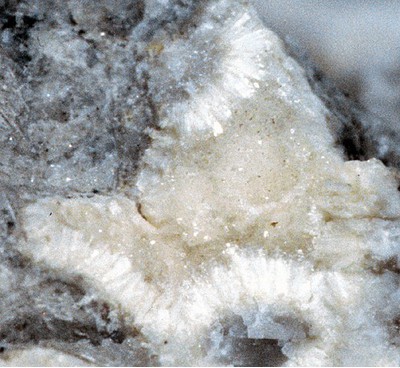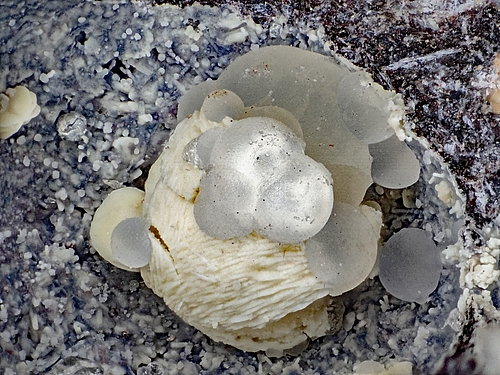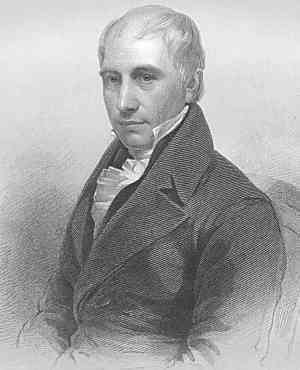Thomsonite-Sr
A valid IMA mineral species
This page is currently not sponsored. Click here to sponsor this page.
About Thomsonite-Sr
Formula:
Na(Sr,Ca)2[Al5Si5O20] · 7H2O
Colour:
Colorless
Lustre:
Vitreous
Hardness:
5
Specific Gravity:
2.47
Crystal System:
Orthorhombic
Member of:
Name:
Named as the Sr-dominant analogue of thomsonite-Ca.
The root name thomsonite is in honor of Thomas Thomson (12 April 1773 Crieff, Perthshire, Scotland - 2 July 1852 Kilmun, Argyleshire, Scotland), professor of chemistry at the University of Glasgow. Thomson was an indefatigable mineral chemist and contributed enormously to the number of accurate chemical analyses of minerals during his career as well as having discovered many new mineral species.
The root name thomsonite is in honor of Thomas Thomson (12 April 1773 Crieff, Perthshire, Scotland - 2 July 1852 Kilmun, Argyleshire, Scotland), professor of chemistry at the University of Glasgow. Thomson was an indefatigable mineral chemist and contributed enormously to the number of accurate chemical analyses of minerals during his career as well as having discovered many new mineral species.
Unique Identifiers
Mindat ID:
28899
Long-form identifier:
mindat:1:1:28899:6
GUID
(UUID V4):
(UUID V4):
6b0e2441-4135-4ca9-aa0b-c4feb0bc79c2
IMA Classification of Thomsonite-Sr
Classification of Thomsonite-Sr
9.GA.10
9 : SILICATES (Germanates)
G : Tektosilicates with zeolitic H2O; zeolite family
A : Zeolites with T5O10 Units – The Fibrous Zeolites
9 : SILICATES (Germanates)
G : Tektosilicates with zeolitic H2O; zeolite family
A : Zeolites with T5O10 Units – The Fibrous Zeolites
Mineral Symbols
As of 2021 there are now IMA–CNMNC approved mineral symbols (abbreviations) for each mineral species, useful for tables and diagrams.
Please only use the official IMA–CNMNC symbol. Older variants are listed for historical use only.
Please only use the official IMA–CNMNC symbol. Older variants are listed for historical use only.
| Symbol | Source | Reference |
|---|---|---|
| Thm-Sr | IMA–CNMNC | Warr, L.N. (2021). IMA–CNMNC approved mineral symbols. Mineralogical Magazine, 85(3), 291-320. doi:10.1180/mgm.2021.43 |
| Tmp | Kretz (1983) | Kretz, R. (1983) Symbols of rock-forming minerals. American Mineralogist, 68, 277–279. |
| Thm | Whitney & Evans (2010) | Whitney, D.L. and Evans, B.W. (2010) Abbreviations for names of rock-forming minerals. American Mineralogist, 95, 185–187 doi:10.2138/am.2010.3371 |
| Thm | The Canadian Mineralogist (2019) | The Canadian Mineralogist (2019) The Canadian Mineralogist list of symbols for rock- and ore-forming minerals (December 30, 2019). download |
Physical Properties of Thomsonite-Sr
Vitreous
Transparency:
Transparent
Colour:
Colorless
Streak:
White
Hardness:
5 on Mohs scale
Tenacity:
Brittle
Cleavage:
Perfect
[100] Perfect, [010] Good
[100] Perfect, [010] Good
Density:
2.47 g/cm3 (Measured) 2.62 g/cm3 (Calculated)
Optical Data of Thomsonite-Sr
Type:
Biaxial (+)
RI values:
nα = 1.528 nβ = 1.532 nγ = 1.540
2V:
Measured: 62° , Calculated: 72°
Max Birefringence:
δ = 0.012

Image shows birefringence interference colour range (at 30µm thickness)
and does not take into account mineral colouration.
and does not take into account mineral colouration.
Surface Relief:
Low
Dispersion:
weak, r > v
Optical Extinction:
X = a, Y = c, Z = b.
Pleochroism:
Non-pleochroic
Chemistry of Thomsonite-Sr
Mindat Formula:
Na(Sr,Ca)2[Al5Si5O20] · 7H2O
Crystallography of Thomsonite-Sr
Crystal System:
Orthorhombic
Class (H-M):
mmm (2/m 2/m 2/m) - Dipyramidal
Cell Parameters:
a = 13.050 Å, b = 13.123 Å, c = 13.241 Å
Ratio:
a:b:c = 0.994 : 1 : 1.009
Unit Cell V:
2,267.59 ų (Calculated from Unit Cell)
Z:
4
Morphology:
Forms: {100}, {010}, {0О1}, {110}.
Twinning:
None observed.
Comment:
Non-standard space-group setting Pcnn.
Crystal Structure
Load
Unit Cell | Unit Cell Packed
2x2x2 | 3x3x3 | 4x4x4
Unit Cell | Unit Cell Packed
2x2x2 | 3x3x3 | 4x4x4
Show
Big Balls | Small Balls | Just Balls | Spacefill
Polyhedra Off | Si Polyhedra | All Polyhedra
Remove metal-metal sticks
Big Balls | Small Balls | Just Balls | Spacefill
Polyhedra Off | Si Polyhedra | All Polyhedra
Remove metal-metal sticks
Display Options
Black Background | White Background
Perspective On | Perspective Off
2D | Stereo | Red-Blue | Red-Cyan
Black Background | White Background
Perspective On | Perspective Off
2D | Stereo | Red-Blue | Red-Cyan
View
CIF File Best | x | y | z | a | b | c
CIF File Best | x | y | z | a | b | c
Rotation
Stop | Start
Stop | Start
Labels
Console Off | On | Grey | Yellow
Console Off | On | Grey | Yellow
Data courtesy of the American Mineralogist Crystal Structure Database. Click on an AMCSD ID to view structure
| ID | Species | Reference | Link | Year | Locality | Pressure (GPa) | Temp (K) |
|---|---|---|---|---|---|---|---|
| 0012495 | Thomsonite-Sr | Gurbanova O A, Rastsvetaeva R K, Pekov I V, Turchkova A G (2001) Crystal structure of strontium-rich thomsonite Doklady Akademii Nauk SSSR 376 387-390 | 2001 | Khibiny alkaline massif, Kola peninsula, Russia | 0 | 293 |
CIF Raw Data - click here to close
X-Ray Powder Diffraction
Image Loading
Radiation - Copper Kα
Data courtesy of RRUFF project at University of Arizona, used with permission.
Powder Diffraction Data:
| d-spacing | Intensity |
|---|---|
| 2.691 Å | (100) |
| 2.86 Å | (100) |
| 2.96 Å | (100) |
| 3.49 Å | (90) |
| 3.19 Å | (80) |
| 4.66 Å | (80) |
| 6.63 Å | (70) |
Geological Environment
Paragenetic Mode(s):
| Paragenetic Mode | Earliest Age (Ga) |
|---|---|
| Near-surface Processes | |
| 22 : Hydration and low-𝑇 subsurface aqueous alteration (see also #23) |
Type Occurrence of Thomsonite-Sr
Co-Type Localities:
General Appearance of Type Material:
Euhedral prismatic crystals up to 1.0 x 0.2 x 0.2 mm (Rasvumchorr) and zones up to 0.02 mm (Yuksporr).
Place of Conservation of Type Material:
A.E. Fersman Mineralogical Museum, Moscow, Russia.
Geological Setting of Type Material:
In veinlets cross-cutting natrolite of risschorrite pegmatite (Rasvumchorr). In a veinlet cross-cutting urtite, as zones in thomsonite-Ca (Yuksporr).
Associated Minerals at Type Locality:
Synonyms of Thomsonite-Sr
Other Language Names for Thomsonite-Sr
German:Thomsonit-Sr
Russian:Томсонит-Sr
Simplified Chinese:锶杆沸石
Spanish:Thomsonita-Sr
Traditional Chinese:锶桿沸石
Relationship of Thomsonite-Sr to other Species
Common Associates
Associated Minerals Based on Photo Data:
| 1 photo of Thomsonite-Sr associated with Smectite Group | A0.3D2-3[T4O10]Z2 · nH2O |
| 1 photo of Thomsonite-Sr associated with Mesolite | Na2Ca2Si9Al6O30 · 8H2O |
| 1 photo of Thomsonite-Sr associated with Thomsonite-Ca | NaCa2[Al5Si5O20] · 6H2O |
Related Minerals - Strunz-mindat Grouping
| 9.GA.05 | Gonnardite | (Na,Ca)2(Si,Al)5O10 · 3H2O |
| 9.GA.05 | Mesolite | Na2Ca2Si9Al6O30 · 8H2O |
| 9.GA.05 | Natrolite | Na2Al2Si3O10 · 2H2O |
| 9.GA.05 | Paranatrolite | Na2Al2Si3O10 · 3H2O |
| 9.GA.05 | Scolecite | CaAl2Si3O10 · 3H2O |
| 9.GA.10 | Thomsonite-Ca | NaCa2[Al5Si5O20] · 6H2O |
| 9.GA.15 | Edingtonite | Ba[Al2Si3O10] · 4H2O |
| 9.GA.15 | Kalborsite | K6Al4BSi6O20(OH)4Cl |
| 9.GA.20 | Tetranatrolite |
Other Information
Health Risks:
No information on health risks for this material has been entered into the database. You should always treat mineral specimens with care.
Internet Links for Thomsonite-Sr
mindat.org URL:
https://www.mindat.org/min-28899.html
Please feel free to link to this page.
Please feel free to link to this page.
Search Engines:
External Links:
Mineral Dealers:
References for Thomsonite-Sr
Reference List:
Pekov, I. V., Lovskaya, E. V., Turchkova, A. G., Chukanov, N. V., Zadov, A. E., Rastsvetaeva, R. K., Kononkova, N. N. (2001) Thomsonite-Sr (Sr,Ca)2Na[Al2Si5O20]·6–7H2O, a new zeolite mineral from Khibiny Massif (Kola Peninsula) and thomsonite-Ca—thomsonite-Sr an isomorphous series. Zapiski Vserossijskogo Mineralogicheskogo Obshchestva, 130 (4) 46-55
Jambor, John L., Roberts, Andrew C. (2001) New mineral names. American Mineralogist, 86 (9) 1112-1115
Jambor, John L., Grew, Edward S., Roberts, Andrew C. (2002) New mineral names. American Mineralogist, 87. 1509-1513
Localities for Thomsonite-Sr
Locality List
 - This locality has map coordinates listed.
- This locality has map coordinates listed.
 - This locality has estimated coordinates.
ⓘ - Click for references and further information on this occurrence.
? - Indicates mineral may be doubtful at this locality.
- This locality has estimated coordinates.
ⓘ - Click for references and further information on this occurrence.
? - Indicates mineral may be doubtful at this locality.
 - Good crystals or important locality for species.
- Good crystals or important locality for species.
 - World class for species or very significant.
(TL) - Type Locality for a valid mineral species.
(FRL) - First Recorded Locality for everything else (eg varieties).
- World class for species or very significant.
(TL) - Type Locality for a valid mineral species.
(FRL) - First Recorded Locality for everything else (eg varieties).
All localities listed without proper references should be considered as questionable.
Japan | |
| ... +1 other reference |
| Miyajima (1999) |
Myanmar | |
| Shi et al. (2012) |
Russia (TL) | |
| Pekov et al. (2001) +1 other reference |
| Pekov et al. (2001) +1 other reference |
Quick NavTopAbout Thomsonite-SrUnique IdentifiersIMA Classification Classification Mineral SymbolsPhysical Properties Optical Data Chemistry Crystallography Crystal StructureX-Ray Powder DiffractionGeological EnvironmentType Occurrence SynonymsOther LanguagesRelationshipsCommon AssociatesStrunz-MindatOther InformationInternet Links References Localities Locality List






 symbol to view information about a locality.
The
symbol to view information about a locality.
The 



Rasvumchorr Mt, Khibiny Massif, Murmansk Oblast, Russia